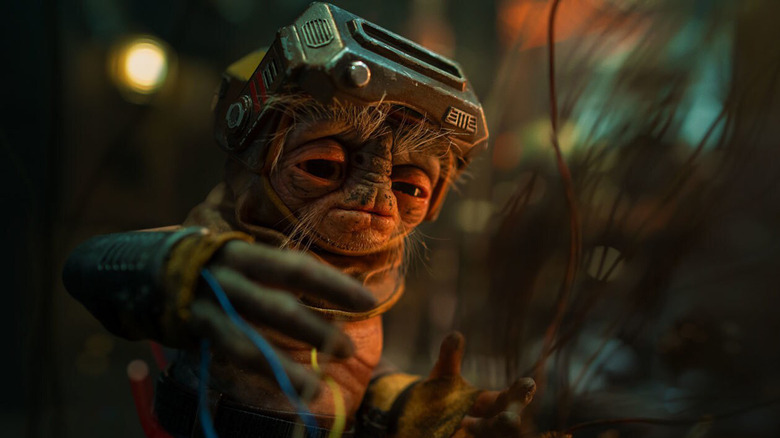Star Wars: The Rise Of Skywalker Creature Designer Neal Scanlan Talks Babu Frik, Cool Aliens You Didn't See, And More [Interview]
Creature and Special Make-up Effects Creative Supervisor Neal Scanlan began his career working on films such as Walt Disney's Return to Oz, Jim Henson's Labyrinth and the 1986 Oscar-nominated Little Shop of Horrors. A founding member of the Jim Henson Creature Shop, Neal was involved in projects such as Witches, Babe (for which he won an Academy Award for Best Visual Effects), 101 Dalmatians, The English Patient, and more.
In 2011, Scanlan was asked to head up the Creature and Make-Up FX department for the new series of Star Wars movies. He has worked on every film of the Disney era: The Force Awakens, Rogue One, The Last Jedi, Solo, and the final episode of the nine-part Skywalker Saga, The Rise of Skywalker.
With The Rise of Skywalker now available on Digital HD and hitting 4K Ultra HD, Blu-ray, and DVD on March 31st, I recently got the chance to speak to Scanlan about his work on the film. He discussed the process of creating creatures for the saga, the origins of Babu Frik, and some tantalizing details on a character we didn't see: The Eye of Webbish Bog.
I'm curious as to how your work begins on a Star Wars film. Are you brought on while the script is in development? Are you pitching ideas and conceptualizing things that will inform the story, or is the script already finished by the time you're brought on?
To be honest it varies. When we first started on The Force Awakens, the script was quite well-shaped. There was a pretty good overall view of what the film story was and where the key story moments were. When Rian [Johnson] came on to do The Last Jedi, then the script was almost completely locked down. The script was absolutely there, and he was very clear about exactly where he wanted to go. With The Rise of Skywalker, we literally started with J.J. [Abrams] from day one, conceptualizing and playing around with ideas with J.J. sort of almost writing the script as we go based on a kind of general feeling of where we are.As a department, when we started on The Force Awakens, we actually never finished. We rolled from one project to the next. And so, we became involved very, very early on with all the films that followed The Force Awakens. During that time, I suppose to a large extent, we help formulate ideas and assist the director in visualizing the film, not just the creatures but environments, et cetera.
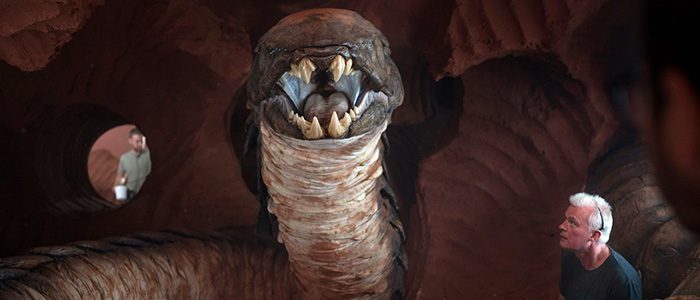
I've watched The Skywalker Legacy documentary and all the bonus features included on the home video release, and I'm just so amazed by all the work that went into the Aki-Aki and the Vexis Snake and, of course, Babu Frik. For the serpent, you built this incredible practical puppet that was enhanced by CGI. Can you talk about that process? Is the puppet there mainly for the actors' reference?
A lot of what we do now is essentially re-skin an existing practical effect with CGI, typically to enhance an element of the character. like the interior of the mouth in this case. I don't think there was ever a feeling that it was going to be completely practically or entirely CG. It was one of those characters where we said, "Let's start practically and see where it goes." The great thing about that is that J.J., Daisy [Ridley] and the rest of the cast are interacting with something real. You get a real performance that's directed in-camera by J.J. that has some level of spontaneity about it that can develop organically during the actual takes. And then you can go in later and say, "Okay, we're going to add a little bit here, we're going to add a little bit there."
Babu Frik is an instantly iconic Star Wars character. Can you walk me through the origins of creating and building that character, and at what point was the decision made to have Shirley Henderson actually perform the character on set?
So Babu started very, very early on in pre-production. J.J. had an idea for a character who was a bit more like a fortune teller initially. He had some knowledge that was an important story point and Rey was going to visit him in order to be able to glean this information. J.J. thought of him as living in his own little world — it was almost like you pull back curtains and behind them was this tiny character that you sat in the presence of.And so, you can imagine the kind of creative conversations we were having. But functionally, one of the things that came out of these creative conversations was that we could do the character as a little rod puppet, but time goes on and story ideas change and develop and so did Babu's role, though we had already committed to the fact that he was going to be rod puppet.
Ivan Manzella, who is part of our concept team, did a full-size, eight-inch Marquette of this little character with a slightly offset eye and all these quirky features. We all saw it and thought it was absolutely stunning. J.J., Kathleen [Kennedy], and Michelle [Rejwan] (Senior Vice President of Live Action Development & Production) saw it and felt the same. So it was like, "Okay, we know what Babu looks like, and we know he's going to be a rod puppet," but we weren't really sure what his role was yet.Once his role was defined, Shirley got involved. J.J. wanted her to vocalize the lines and perform the character, so she came to work with us and became one of the puppeteers. We showed Shirley how to use the controller that operated Babu's mouth and lips, and she worked with us for a weekend during rehearsals in which the voice slowly appeared. It started as grunts and unintelligible words and became this incredible voice she came up with. When you get this chemistry between the person vocalizing the line, puppeteering the line, and the other puppeteers, you get this sort of synergy that happens between them and each one sparks off the other. You hear a certain giggle or funny noise that Babu makes and the puppeteers respond to that.
When we were on set, it takes on another level when you hear J.J. or the cast laughing because of something Shirley and the other puppeteers are doing. It became a really fun piece of live theater I suppose. And that's how we arrived at the performance, other than just a sort of clinical analysis of what his mood needed to be or what his action to be. The rest of it was more just sort of these people working with each other and having fun.
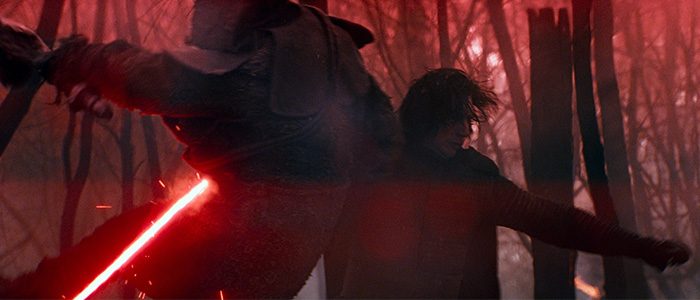
I've read The Rise of Skywalker novelization and devoured all the concept art from the film I could find, and I'd love to ask you about this oracle-type character, The Eye of Webbish Bog, that doesn't appear in the film. Did you build a full-size version of that creature and was that sequence actually filmed? [Glimpsed in behind-the-scenes photos, The Eye of Webbish Bog is a spider-like being on the planet Mustafar. It is locked in symbiosis with a blind giant and lives in a lake. In an earlier cut of the film, Kylo Ren visits the creature to learn the location of Darth Vader's Sith wayfinder.]
We did exactly that. It was concept designer Jake Lunt Davies who conceived the character. In many ways, The Eye of Webbish Bog was similar in J.J.'s mind, I think, to Babu Frik in that they had important information that would guide the characters on their journey. Jake did this drawing and J.J. latched onto it, loved it, and said, "Well, we have to make this happen." So we did. We built this full-size sort of giant baby head that sits in water, and built an animatronic spider-like character that sits on top, which was performed through slots in the giant baby's head.
Wow.
And the whole thing was taken to Black Park, which is adjacent to Pinewood Film Studios and has been used as an outdoor location for Hammer horror films and many of the British comedy films of the '60s and '70s, et cetera. In the center of Black Park, there's a lake, and construction built this platform that allowed us to float the entire thing on the lake. It was filmmaking on a grandeur scale. So yes, the whole sequence was shot. Absolutely. It does exist as footage but, unfortunately, there just wasn't enough time in the movie.
I hope it shows up one day. I was sad to see that the sequence wasn't included as a deleted scene – I would love to see it.
Yeah, it was a very fun sequence to do, and one of those ones that I would say, had it been in the film, I would have said that it was one of the things that stuck out to me from all of the films. Just because again, the extraordinary lengths we went to in order to do it as a practical entity.
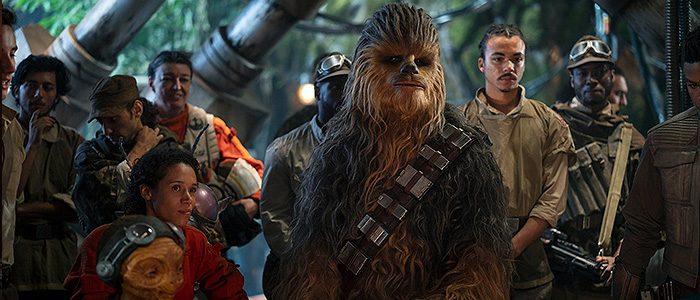
When it comes to recreating legacy characters like Chewbacca, Yoda, and Wicket, do you find that new technologies or materials can't replicate the original designs accurately? Is it easier or more difficult to capture these characters today?
You're right, and that's very clever of you to say. You have to be careful. The first thing that I did was look at Chewie and what Stuart Freeborn had done with the design and make sure we were as faithful in our replication as we possibly could be. We didn't feel that there was room for our own interpretation — our own ego. We found it very humbling to do that because you often look back on things people have done in the past and think, "Oh, they must've done that quite simply" or they must have done it this way or that way because they didn't have the tools or technology at the time. But what you actually find is that they did it that way because they were very, very clever people.
One example of that is that Stuart Freeborn's wife, Kay, knitted Chewie's bodysuit. In those days, they wouldn't have had material like Lycra or two-way stretch fabric. So she knitted it out of wool and you think, "Well, we don't need to do that. We'll do it out of Lycra." But there is something that was so, so clever about what she was doing. What she understood was that knitted wool has a weight — the way a heavy jumper moves is very, very different than the way much lighter, modern materials do. We learned very quickly that the only way we could do Chewie was to knit certain parts of his bodysuit in order to give it that same weight.
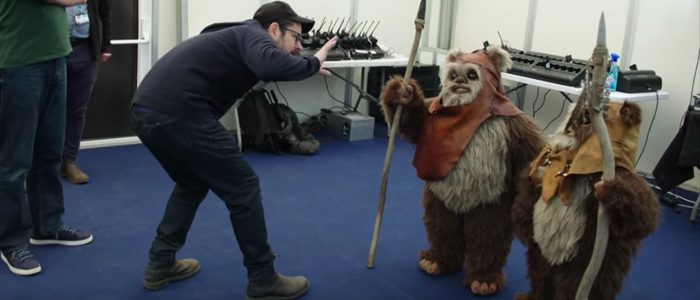
When we came to the Ewoks, we got Warwick Davis to come in and Warwick talked us through how Stuart had built the Ewok suits. We really wanted Warwick to feel like he was in the same suit he was in when he was a young person just starting out. So we built it on his advice, and we built it using the same materials that Stuart used.For Emperor Palpatine's makeup, we looked at exactly what had been used on Ian McDiarmid before —the old age stipple, the foam latex. We did, in that particular case, use some more modern materials, as far as the PlatSil Gel and appliances were concerned, but only very tentatively because you just don't get as an authentic replication. It's not authentic if you use silicones. Yoda would not have looked the same if we hadn't made him the same way as Stewart had made him.
You've worked on every Star Wars film thus far in the Disney era. When we look back on these films years from now, fans are going to talk about your work in the same way that we talk about the contributions of Phil Tippet, Stuart Freeborn, John Knoll, and others. Have you had a chance to take that in, and consider your place within the legacy of Star Wars itself, and just kind of what the Skywalker saga means to you as it sort of culminates?
Well, I am incredibly complimented by your words. Thank you so much. I would never imagine myself in that company of people, so I find that rather spine-chilling to think that would be the case, and how incredible if it were.
I think that really for me, the thing that has most registered is that I had a chance that very few people have. I had already had a long career that had gone through a huge learning curve and then I had the chance to take everything I had learned, all that experience and all that wisdom and start all over again! You know, I was lucky enough to be around when animatronics was in its infancy when people like Rick Baker and those greats were pushing the boundaries forward ultimately to Stan Winston's work on Jurassic Park. And then, with this new Star Wars trilogy, to have a new start and I just thought, "Right, okay, if you could do it all over again, how would you do it now?" And, that's what these films have done for me and for my crew. It's allowed us to re-evaluate how we want to do things, what can we do, and how will we do it differently this time. And it's an extraordinary feeling to have; an extraordinary opportunity to be given.
Now with digital, we're able to say "Okay, let's park these ideas that maybe aren't as well suited for today." We can use the digital medium that we didn't have back then to help us push the practical effects and hopefully we can keep expanding on that. So, I have been incredibly appreciative of this Star Wars journey. In so many ways, what has motivated us is knowing that the next film was another opportunity to keep pushing ourselves. So, that's been phenomenal. But as to my work being compared with the people that you previously mentioned, well, that would be a lovely thought!
